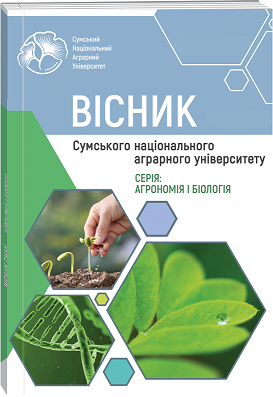FEATURES OF THE YEILD FORMATION OF SUNFLOWER HYBRIDS IN THE CONDITIONS OF THE NORTH-EASTERN FOREST STEPPE OF UKRAINE
Abstract
Sunflower belongs to crops with low pre-harvest sowing density and low compensatory capacity of the parameters that are components of the crop. This feature complicates the functioning of population mechanisms of regulation of generative parameters of plants in the same way as it happens in crops of cereal crops. The success of realizing the generative potential of plants (сrop yield) is determined by the compliance of the mechanisms of plant productivity, created through selection, to specific environmental conditions. Under these conditions, the most effective method of stabilizing and increasing crop yield is the correct selection of hybrids. To evaluate the effectiveness of various yield formation schemes 9 sunflower hybrids were studied in 2019–2021. Research was carried out within the framework of scientific topics of the Sumy National University and the Institute of Agriculture of the North East of the National Academy of Sciences. The conditions of the field experiment reproduced the main range of agrotechnical ones for sunflower growing in the northeastern forest-steppe zone of Ukraine. The range of weather conditions over the years of research contributed to the identification of genotypes that were characterized by the ability to actively grow in conditions of low temperatures and sufficient amount of precipitation in the juvenile phases of development, as well as the ability to realize the generative potential of plants at higher temperatures and moisture deficit in the second half of the growing season. Yield indicators and their deviations from the average means were analyzed in terms of hybrids, years of research and rates of mineral fertilizers. Evaluation of productivity formation schemes was carried out on the basis of the indicator of ecological plasticity for the main selectively controlled traits. According to the study results of sunflower hybrids reaction to the year conditions and the fertilizer rate, it was established that: 1) Differences in the average yield indicators of individual research years increase with application of average rate of mineral fertilizers. On the variant with the maximum fertilizer rate the opposite effect was observed: the reaction of hybrids to the differences in weather conditions during the research years was weakened; 2) The high level of similarity in the reaction of low-yielding hybrids to weather conditions is based on a common complex of genetic mechanisms of yield formation. However, higher than average level of yield in each specific case is provided by an individual genetic scheme; 3) Comparison of hybrids according to the indicator of ecological stability of the main selectively controlled traits indicates the expediency to select of three groups with different schemes of yield formation: with a high level of plasticity of 1000 seed weight and the development of the leaf apparatus (Phenomen, Jason and Nabir); with a high level of plasticity of most indicators, primarily the number of seeds, the size of the inflorescence and the development of the leaf apparatus (Agent and LG 53.77); with an average level of plasticity according to the main selectively controlled indicators (Theo, Oscar, Zlatson and Dobrodiy).
References
2. Anastasi, U., Cammarata, M. & Abbate, V. (2002). Yield potential and oil quality of sunflower (oleic and standard) grown between autumn and summer. Ital. J. Agron., 4, 23–36.
3. Andrade, F. H., Sadras, V.O., Vega, C.R.C. & Echarte, L. (2005) Physiological determinants of crop growth and yield in maize, sunflower and soybean: their application to crop management, modeling and breeding. J. Crop Improv. 14, 51–101.
4. Baranyk, P. (2010) Olejniny. Vyd. Profi Press, Praha, 206.
5. Brandt, S. A., Nielsen, D. C., Lafond, G. P. & Riveland, N. R. (2003) Oilseed crops for semiarid cropping systems in the Northern Great Plains. Agronomy Journal, 94, 31–240.
6. Canavar, Ö., Ellmer, F. & Chmielewski, F.M. (2010). Investigation of yield and yield components of sunflower (Helianthus annuus L.) cultivars in the ecological conditions of Berlin (in Germany). HELIA, 33(53), 117–130. doi: 10.2298/ HEL1053117C
7. Černý, I., Pačuta, V., Veverková, A.& Bacsová, Z. (2010). Zhodnotenie kvalitat ívnych a kvant itatívnych parametrov slnečnice ročnej (Helianthus annuus L.) vplyvo m vybraných faktorov jej pestovania. Sborník z konference „Prosperující olejniny“, 9–10.
8. De la Vega, A. J. & Hall, A. J. (2002) Effects of planting date, genotype, and their interactions on sunflower yield. Crop Sci. 42, 1191–1201. doi: 10.2135/cropsci2002.1191
9. Denčić, S., Mladenov, N. & Kobiljski, B. (2011) Effects of genotype and environment on breadmaking quality in wheat. Int. J. Plant Prod., 5(1), 71–82.
10. Dicu, V. G., Băúa, A. G. & State, D. (2013) Yield components at some hybrids of sunflower (Helianthus annuus L.) under drought conditions from south Romania. AgroLife Scientific Journal, 2, 9–14.
11. Duca, M., Port, A., Burcovschi, I., Joiţa-Păcureanu, M. & Dan, M. (2022) Environmental response in sunflower hybrids: a multivariate approach Romanian Agricultural Research, 39, 2–14.
12. Đukić, V., Balešević-Tubić, S., Đorđević, V., Tatić, M., Dozet, G., Jaćimović, G., & Petrović, K. (2011). Prinos i semenski kvaliteti soje u zavisnosti od uslova godine. Ratar Povrt., 48, 137–142.
13. Eberhart, S. A. & Russel, W.A. (1966). Stability parameters for comparing varieties. Crop Sci., 6, 6–40.
14. Ghaffari, M., Farrokhi, I. & Mirzapour, M. (2011) Combining ability and gene action for agronomic traits and oil content in sunflower (Helianthus annuus L.) using F1 hybrids. Crop Breeding Journal, 1(1), 75–87.
15. Gonzáles, J., Mancuso, N. & Ludueña, P. (2013). Sunflower yield and climatic variables. HELIA, 36(58), 69–76. doi: 10.2298/hel1358069g
16. Hladni, N., Škorić, D., Kraljević-Balalić, M., Sakač, Z. & Jovanović, D. (2006) Combining ability for oil content and its correlations with other yield components in sunflower (Helianthus annuus L). HELIA, 29(44), 101–110. doi: 10.2298/ hel0644101h
17. Нossam, M. I. (2012) Response of some sunflower hybrids to different levels of plant density. APCBEE Procedia 4, 175–182.
18. Ion, V., Dicu, G., Băúa, A.Gh. & State, D. (2013) Yield components at some hybrids of sunflower (Helianthus annuus L.) under drought conditions from South Romania. AgroLife Scientific Journal, 2(2), 9–14.
19. Ion, V., Stefan, V., Dumbravă, M., Ion, N. & Băúa, A. Gh., (2010). Yield results obtained from an assortment of sunflower hybrids cultivated at Moara Domnească Research Farm in the period 2006-2008. Scientific Papers. Series A. Agronomy, LIII, 364–370.
20. Iqrasana, Qayyum, A., Khan, S. U., Khan, S.A., Mehmoody, A., Bibi, Y., Sherh, A., Khanm, H. & Jenks, M. A. (2017) Sunflower (Helianthus annuus) hybrids evaluation for oil quality and yield attributes under spring planting conditions of Haripur, Pakistan. Planta Daninha, 35 doi: 10.1590/S0100-83582017350100003
21. Joksimovic, J., Atlagic, J., Jovanovic, D., Marinkovic, R., Dušanic, N. & Miklic, V. (2004) Path coefficient analysis of some head and seed characteristics in sunflower. Proc 16th International Sunflower Conference, Fargo, North Dakota, USA, 525–530.
22. Kalenska, S., Ryzhenko, A., Novytska, N., Garbar, L., Stolyarchuk, T., Kalenskyi, V., & Shytiy, O. (2020) Morphological features of plants and yield of sunflower hybrids cultivated in the northern part of the Forest-Steppe of Ukraine. American Journal of Plant Sciences, 11, 1331–1344. doi: 10.4236/ajps.2020.118095
23. Marinković, R. (1992) Path-coefficient analysis of some yield components of sunflower (H. annuus L.) I. Euphytica, 60, 3, 201–205. doi: 10.1007/BF00039399
24. Marinković, R., Škorić, D., Nenadić, N., Jovanović, D., Miklič, V., Joksimović, J., Stanojević, D., & Nedeljković, S. (1994). Uticaj položaja semena u glavi na prinos i neke komponente prinosa semena kod suncokreta (Helianthus annuus L.). Zbornik radova Instituta za ratarstvo i povrtarstvo, 22, 379–389.
25. Marinković, R., Dozet, B., & Vasić, D. (2003). Oplemenjivanje suncokreta. Monografija. Školska knjiga, Novi Sad, 368.
26. Melnyk A. V., Trotsenko V. I. & Hovorun S.O. (2013) Vplyv poperednykiv ta mineralnykh dobryv na yakist nasinnia soniashnyku v umovakh pivnichno-skhidnoho lisostepu Ukrainy [The influence of precursors and mineral fertilizers on the quality of sunflower seeds in the conditions of the northeastern forest-steppe of Ukraine] Visnyk Sumskoho natsionalnoho ahrarnoho universytetu., 11 (26), 124–127 (in Ukrainian).
27. Miklič, V., Dušanić, N., Joksimović, J. & Crnobarac, J. (2006). Uticaj vremena berbe na masu 1000 semena različitih genotipova suncokreta. Zbornik radova, Savetovanje industrije ulja, Herceg Novi, 55–61.
28. Mirić, М., Selaković, D., Jovin, P., & Hojka, Z. (2006). Masa 1000 semena u teoriji i praksi. Zbornik abstrakata, IV Simpozijum selekcije i semenarstva, Zlatibor, 172. 29. Moghaddam, M. J. & Pourdad, S. S. (2011) Genotype × environment interactions and simultaneous selection for high oil yield and stability in rainfed warm areas rapeseed (Brassica napus L.) from Iran. Euphytica, 180, 321–335. doi: 10.1007/s10681-011-0371-8
30. Mrdja, J., Crnobarac, J., Dušanić, N., Jocić, S. & Miklič, V. (2011) Germination energy as a parameter of seed quality in different sunflower genotypes. Genetika-Belgrade, 43(3), 427–436. doi: 10.2298/GENSR1103427M
31. Mrdja, J., Crnobarac, J., Radić, V. & Miklič, V. (2012) Sunflower seed quality and yield in relation to environmental conditions of production region. HELIA, 35(57), 123–134. doi: 10.2298/hel1257123m
32. Pissai, C. (2011) Stability of yield and other characters of sunflower across environments. Suranaree Journal Science and Technolog, 18, 55–60.
33. Piva, G., Bouniols, A. & Mondiès, M. (2000) Effect of cultural conditions on yield, oil content and fatty acid composition of sunflower kernel. International sunflower conference, 15, Toulouse. Proceedings Toulouse: ISA, A61–A66.
34. Radić, V. (2008). Proizvodne i morfološke osobine komercijalnih novosadskih linija suncokreta (Helianthus annuus L.). Doctoral dissertation. University of Novi Sad, Faculty of Agriculture.
35. Radić, V., Vujaković, M., Marjanović-Jeromela, A., Mrdja, J., Miklič, V., Dušanić, N. & Balalić, I. (2009) Interdependence of sunflower seed quality parameters. HELIA, 32(50), 157–164. doi: 10.2298/hel0950157r
36. Radiс, V., Mrđa, J., Jockoviс, Mi. , Сanak, P., Dimitrijeviс, Al. & Jociс, S. (2013). Sunflower 1000-seed weight as affected by year and genotype. Ratarstvo i Povrtarstvo. 2013, 50(1), 1–7. doi: 10.5937/ratpov50-3214
37. Schoeman, L. J. (2003) Genotype × environment interaction in sunflower (Helianthus annuus) in South Africa. PhD Thesis. University of the Free State, Bloemfontein, South Africa.
38. Trocenko, V. І. & Zhatova, G. O. (2018). Parametri fotosintetichnogo aparatu sonjashniku v modeljah sortіv dlja zoni pіvnіchno-shіdnogo Lіsostepu ta Polіssja [Parameters of photosynthetic sunflower apparatus in varieties models for the area of the northeast Forest-Steppe and Polissia]. Vіsnik Sumskogo NAU, 8(35), 53‒58 (in Ukrainian).
39. Trocenko V. І. & Zhatova, G. O. (2015). Etapi formuvannja produktivnostі roslin ta urozhajnіst posіvіv sonjashniku [Stages of formation of plant productivity and yield of sunflower crops]. Vіsnik centru naukovogo zabezpechennja APV Harkіvskoi oblastі, 18, 165–173 (in Ukrainian).
40. Vratarić, M., & Sudarić, A. (2004). Oplemenjivanje i genetika suncokreta Suncokret Helianthus annuus L. Poljoprivredni institut, Osijek, 88–89.
41. Vujaković, M., Radić, V., Miklič, V., Jovičić, D., Balešević-Tubić, S., Mrđa, J., & Škorić, D. (2012). Seed dormancy of hybrids and parent lines of sunflower (Helianthus annuus L.). HELIA, 35, 111–118.
42. Zheljazkov, V. D., Vick, B.A., Baldwin, B.S., Buehring, N., Coker, C., Astatkie, T. & Johnson, B. (2011). Oil productivity and composition of sunflower as a function of hybrid and planting date, Industrial Crops and Products, 33(2), 537–543, doi: 10.1016/j.indcrop.2010.11.004

 ISSN
ISSN  ISSN
ISSN 


